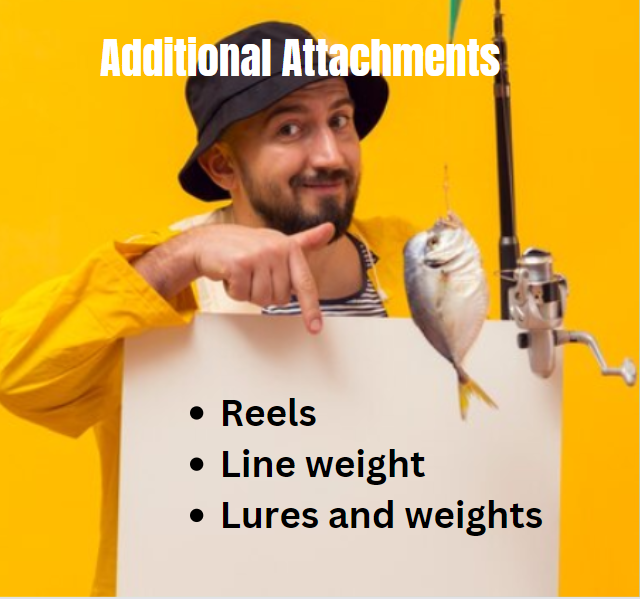Fishing rods are generally buoyant, but they can sink if they are heavy or waterlogged. Certain materials used in rods may increase the likelihood of sinking.
Choosing the right fishing rod is crucial for an enjoyable angling experience. Anglers often consider factors like strength, flexibility, and sensitivity, but whether a rod can sink in water is usually overlooked. Materials such as graphite, fiberglass, and bamboo have different densities and buoyancies.

Some fishing rods, especially older models or those with heavy components, may indeed become submerged if dropped into water. This introduction aims to give a clearer understanding of the buoyancy of fishing rods and what impacts it. The concern of losing a prized rod to the depths makes the selection process even more significant, especially for those fishing in deep waters or from a boat. Let’s check Can Fishing Rods Sink in Water or not.
The Density Of Fishing Rods
When it comes to fishing, the success of your catch can sometimes come down to the quality of your equipment. Among these, the fishing rod is the staple tool for any angler. But what happens if it slips out of your grip? A common question arises: can fishing rods sink in the water? The answer isn’t as straightforward as one might think. It all boils down to the density of the fishing rod compared to the water it falls into.
Buoyancy Of Fishing Rods
Understanding buoyancy is crucial when contemplating whether a fishing rod will float or sink. Archimedes’ principle states that the buoyant force on an object is equal to the weight of the fluid it displaces. Consequently, if a fishing rod is less dense than the water, it will float; if it is denser, it will sink.
- Fishing rods typically have a density less than water, aiding in their buoyancy.
- Many rods are designed with hollow sections to reduce overall density.
- Features like grips and reel seats may influence buoyancy.
Materials Affecting The Buoyancy
The materials used in a fishing rod greatly influence its ability to stay afloat. Most rods are crafted from materials such as fiberglass, graphite, or composite blends, which inherently have different densities and buoyant properties. Let’s Plunge into the specifics:
| Material | Density | Buoyancy |
|---|---|---|
| Fiberglass | Low | Generally, float |
| Graphite | Low to Moderate | May float or sink depending on the design |
| Composite | Varies | Depending on the blend of materials |
Also to the core materials, other components like the hardware, grips, and interior foam can contribute to buoyancy. Lightweight materials like cork or EVA foam grips can assist in keeping the rod afloat, while heavier fittings might lead to the opposite effect.
Construction And Buoyancy
Construction and Buoyancy of fishing rods are critical factors not only in the performance and handling of the rod but also in its ability to float or sink when dropped in water. It’s a question many anglers have pondered: can fishing rods sink in water? Understanding the factors that contribute to a rod’s buoyancy— or lack thereof—is vital for anyone looking to protect their investment from an accidental plunge.
Role Of Materials In Rod Construction

The core materials used in crafting fishing rods play a pivotal role in their final buoyancy. Most rods are made from lightweight and durable materials such as fiberglass, graphite, or composite blends. These materials are carefully selected for their strength-to-weight ratio and flexibility, crucial in the fight against fish. The density of these materials, while low, is still greater than water, which means they could potentially sink without additional buoyant elements.
- Fiberglass rods – heavier, more flexible, but less buoyant than graphite.
- Graphite rods – lighter and stiffer, offering better buoyancy characteristics.
- Composite rods – offer a balance between the two, with buoyancy dependent on specific material ratios.
Foam Grips And Handles
One key component that helps improve the buoyancy of fishing rods is the use of foam grips and handles. Foam not only provides comfort for the angler but also adds necessary flotation to the rod. This is why many fishing rods that incorporate foam in their construction will float, at least temporarily, if they are dropped in the water.
| Type of Foam | Characteristics | Impact on Buoyancy |
|---|---|---|
| EVA Foam | Durable, lightweight, resistant to UV rays | Increases rod buoyancy |
| Cork | Natural material, comfortable grip | Neutral to slightly buoyant |
Incorporating foam into the construction of handles and grips is a strategic design choice. EVA foam, for example, not only serves to lighten the overall weight, but its cellular structure also traps air, enabling the fishing rod to resist sinking. On the other hand, cork, another popular material for rod handles, while not as buoyant as some synthetic foams, can still aid in keeping a rod afloat if it’s not weighed down by other accessories or hardware.
Factors Affecting Floating Ability
Fishing enthusiasts often wonder about the buoyancy of their gear while out on the water. Of special interest is the floating ability of a fishing rod, a factor that can be pivotal during those unexpected situations where the rod may end up overboard. The ability of a fishing rod to float or sink is influenced by Different elements, where its weight and any extra attachments play significant roles. This section Investigates into these factors to help anglers understand how they contribute to the floating ability of a fishing rod.
Weight Of The Fishing Rod

The inherent weight of a fishing rod is a primary factor in determining whether it will float or sink. Most rods are designed to be lightweight, enhancing usability and comfort during long fishing sessions. The following attributes are crucial:
- Material composition: Rods made from buoyant materials such as bamboo, fiberglass, or certain composites tend to have better-floating capabilities.
- Overall density: A rod’s density is critical, as denser rods, even those that are lightweight, may still sink.
- Buoyancy distribution: If the weight is evenly distributed along the rod’s length, it can assist with flotation.
Typically, if a fishing rod is light enough, it might stay afloat temporarily, but the decision between sinking or floating isn’t solely dependent on weight alone. Additional factors come into play.
Adding Additional Attachments

Attachments add functionality to fishing rods but also affect their buoyancy. Consider these common add-ons:
- Reels: Attaching a heavy reel can tip the balance toward sinking, as metals and dense materials commonly found in reels add significant weight.
- Line weight: The type and weight of the fishing line wound around the reel can also impact flotation. Heavier lines or soaked lines may contribute to a greater sinking risk.
- Lures and weights: The inclusion of large lures or additional weights for deep-sea fishing can turn an otherwise buoyant rod into one that readily sinks.
Aftermarket flotation devices can be affixed to rods to improve their floating capability, which is a strategic move for accident-prone environments.
Understanding these factors equips anglers with the foresight to Upgrade their rods’ floating abilities or take precautions to prevent rods from sinking. Whether fishing in the calm of a lake or the unpredictable nature of the sea, recognizing the role each component plays can save you the distress of watching your favorite fishing rod disappear into the depths below.
Implications For Fishing
When we Plunge into the subtleties of fishing, we rarely contemplate the buoyancy of our tools. Yet, understanding whether fishing rods sink or float has direct implications for the fishing experience. Should your rod accidentally slip out of your grasp, knowing its fate can drastically impact your approach to the sport and your readiness for unexpected challenges?
The effects of fishing extend far beyond catching fish; they encompass a complex web of consequences. Overfishing, driven by the demand for seafood, poses a significant threat to marine life. This practice, coupled with destructive methods like bottom trawling and the haunting presence of ghost nets, leads to habitat destruction and disrupts entire ecosystems.
Climate change is another pivotal factor altering the fishing landscape. Ocean warming, acidification, and shifting currents all have implications for fishing. The compounding impacts of rising sea temperatures exacerbate these challenges. These changes not only jeopardize fish populations but also have health consequences for marine life and the humans dependent on them.
Management is key. Implementing sustainable practices and raising awareness about the negative effects of destructive fishing methods can mitigate these implications, fostering a more positive impact on both the environment and fishing communities.
Effects On Fishing Experience
The moment a fishing rod tumbles into the water, the outcome shapes your day on the lake or river. A sinking rod not only means the potential loss of a valued piece of equipment but also a disruption of your tranquil excursion. Fishing rods designed with denser materials will sink, often leading to hurried and frantic retrieval attempts. This can cause significant stress and dissatisfaction, transforming a leisurely pastime into a race against time. Contrastingly, rods that stay afloat offer the angler a safety net, permitting a more relaxed and enjoyable experience.
Influence On Fishing Techniques And Strategies
The prospect of a sinking rod influences how anglers approach their craft. Techniques and strategies must adapt to minimize the risk of accidental submersion. For instance, anglers might need to invest in specialist equipment such as rod floatation devices or harnesses to secure rods in place. Strategies could include meticulous planning, ensuring a safe setup of fishing spots, and constant vigilance, especially in turbulent waters. This level of preparedness not only guards against loss but also instills a sense of confidence and focus on the art of fishing itself.
Water Resistance And Sinking
Fishing enthusiasts often ponder whether fishing rods can sink in water. At first glance, it may seem that these slender items, dependent on their build and material, should simply float indefinitely. The relationship between water resistance and fishing rods isn’t quite that straightforward. Tackling this area is crucial because knowing your gear’s capabilities and limitations can mean the difference between securing a catch and losing a rod to the depths.
Impact Of Water Resistance
Water resistance plays a pivotal role in determining if a fishing rod will sink or float. The concept is fairly simple: objects less dense than water float, while those denser than water tend to sink. But with fishing rods, it’s about more than just density. The design and materials of the rod also come into play, affecting how it interacts with water resistance. Factors like surface area, buoyancy, and the weight distribution within the rod influence its sinking behavior.
Behavior Of Different Rod Types In Water
Different fishing rod types exhibit distinct behaviors when submerged. Let’s Investigate into the dynamics of three main types:
- Graphite Rods: Known for their lightweight and high sensitivity, graphite rods also tend to sink due to their dense composition.
- Fiberglass Rods: These rods offer more flexibility and endurance. They are usually denser than water but can be crafted to be buoyant or neutral depending on their design and thickness.
- Composite Rods: A mix of graphite and fiberglass, composite rods balance sensitivity with durability. Their sinking or floating behavior depends highly on the specific proportions and layout of materials within the rod.
| Type of Rod | Density | Typical Behavior in Water |
|---|---|---|
| Graphite | High | Sinks |
| Fiberglass | Variable | Can float or sink |
| Composite | Medium | Depends on composition |
In essence, whether a fishing rod sinks in water is not a matter of simple guesswork but rather a complex interplay of physics and material science. By understanding the impact of water resistance and the behavior of different rod types in water, anglers can better prepare for their aquatic adventures.
Maintenance And Care
Regular maintenance and appropriate care of fishing equipment are paramount for any angler aiming to Upgrade their fishing experience. Not only does this guarantee a longer lifespan for your gear, but it also plays a critical role in preventing mishaps, such as the sinking of a fishing rod during a trip. Understanding how to maintain your rod will help keep it buoyant and in prime condition for all your aquatic adventures.
Preventing Sinking Through Proper Care
Every fisherman knows that the sinking of a rod disrupts a peaceful day by the water, turning fun into frustration. To ensure your rod doesn’t take an unexpected Plunge, follow these maintenance tips:
- Regular Cleaning: After each use, gently rinse your rod with fresh water to remove salt, dirt, and debris that could corrode or damage the rod over time, diminishing its buoyancy.
- Storage: Store your rod in a cool, dry place away from direct sunlight. Use a rod rack if possible to avoid bending or stressing the rod in any way.
- Inspection: Before heading out, inspect your rod for any signs of wear or damage. Cracks, split grips, or loose fittings can compromise the integrity of the rod.
- Repairs: Addressing repairs promptly will help keep your rod in top form. If you notice any issues, take your rod to a professional or fix it yourself, if you’re skilled enough, to prevent further damage.
- Protective Gear: Use a rod cover when transporting your gear to shield it from scratches or impacts that could affect its buoyancy.
Choosing The Right Fishing Rod For Specific Conditions
Selecting a rod that matches the fishing conditions is as critical as proper care. Adherence to these selection guidelines will ensure your rod stays afloat and performs optimally:
- Freshwater vs. Saltwater: Saltwater rods are generally built to resist corrosion and are more buoyant, so opt for these in marine environments.
- Rod Density: Choose a rod with a lower density that inherently has better flotation properties, like those made from foam or certain types of wood.
- Weight: Lighter rods are less likely to sink quickly, offering you more time to retrieve them if they fall in the water.
- Length: Longer rods can be more challenging to manage and may increase the likelihood of taking a plunge. Assess your skill level and choose a rod length accordingly.
- Guides and Reel Seats: Quality components help maintain the integrity of the rod. Select rods with secure, non-corrosive guides and reel seats. In summary, proper maintenance of your fishing rod is as important as the rod’s inherent characteristics when it comes to staying afloat. Commit these care tips and selection criteria to memory, and your rod will serve you well, won’t readily sink, and will let you stay focused on the catch rather than your gear staying afloat.
Frequently Asked Questions On Can Fishing Rods Sink In Water
Do Fishing Rods Float Or Sink?
Most fishing rods, being made of materials like graphite, fiberglass, or bamboo, are naturally buoyant. They can still sink if weighed down by attached equipment, like reels or lures, especially in deeper or turbulent waters.
What Affects A Fishing Rod’s Buoyancy?
The buoyancy of a fishing rod is determined by its materials and construction. Rods with larger diameters and hollow interiors tend to float better. Additional gear attached to the rod, such as reels and hooks, can also impact its floating capability.
Can Saltwater Cause Fishing Rods To Sink?
Saltwater itself doesn’t cause fishing rods to sink. Despite that, it can affect the buoyancy if the rod absorbs water or gets encrusted with salt, which adds weight and might increase the likelihood of sinking.
How To Prevent Losing A-Rod When Fishing?
To prevent losing a fishing rod, you can use rod floatation devices or leashes. Also, ensure your grip is secure, especially in rough conditions, and consider using a rod holder to keep it in place when not actively in use.
Conclusion
Understanding the buoyancy and material makeup of fishing rods is crucial. They can indeed sink, particularly if they’re made from dense components or are not designed to float. To prevent watery mishaps, choosing the right rod for your fishing needs is vital.
Remember, safety and preparedness Upgrade your angling adventure, ensuring your gear stays above water and ready for the catch.

